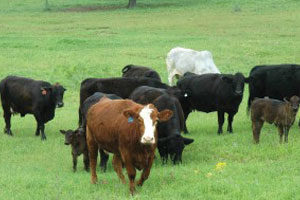“With restocking beginning on some operations, carrier cattle from areas where infection is common could be problematic.”
Hairgrove and Dr. Pete Teel, Texas A&M AgriLife Research entomologist at College Station, provided a briefing to faculty members recently in the department of animal science at Texas A&M University.
Cattle can become infected with bovine anaplasmosis through transfer of red blood cells.
Hairgrove said, “Horse flies and deer flies are mechanical carriers and the infected blood on their mouth parts is the only way they can spread the disease.
“Contaminated ear tagging instruments, needles and surgical instruments used while working cattle also can be a cause of transmission. Thoroughly clean instruments and change needles between cows.”
Biological vectors such as ticks can also be carriers. Teel said two Dermacentor ticks, the winter tick and the American dog tick, may serve as both vectors and reservoirs to sustain the disease in Texas.
“The winter tick attacks cattle and other large animals such as deer and horses from October to April,” Teel said. “They feed as larvae, nymphs and adult ticks on the same host, but may be groomed off as bloodfed-nymphs which molt to adults and then attach to another host. If the initial host is an infected cow, and the second is not, transmission of the anaplasma agent may occur.
“The American dog tick attacks a wide variety of animals and feeds separately on three hosts, one for larvae, nymphs and adults, respectively.
“Small-, medium- and large-sized animals are included, often in a progressive fashion,” Teel said.
“However, cattle are known to be attacked by nymphs, which fall off when blood-fed to become adult ticks. The adult ticks can then transmit the agent acquired as a nymph to a non-infected cow. Spring and summer are the primary seasons of activity for the American dog tick. Thus, ticks are a year-round risk for transmission of the anaplasma agent.”
“For ranchers, the potential for the disease is greater when co-mingling non-infected cattle with those that carry the disease. Such an example is when ranchers introduce purchased cattle to those in an existing herd, the purchased cattle could be carriers – on the flip side, introducing non-carrier cattle into a carrier herd could also be problematic,” Hairgrove said.
Cattle that survive initial infection become lifetime carriers of the infection and are important to disease epidemiology.
“Red blood cells have a 160-day lifespan and newly developed erythrocytes must be continually infected to maintain persistent infection,” Hairgrove said. “Although all ages of cattle can become infected, the disease is usually not apparent in animals less than a year of age. Disease is more prevalent in cattle more than three to four years of age.”
There are preventive aids that ranchers can use.
“Ranchers should use strict adherence to sanitation procedures when using needles, surgical instruments, ear taggers, etc.,” Hairgrove said.
As an additional preventive measure, strategically feed Tetracycline during the vector season, he said. Beef producers can consult with their local veterinarian for additional control measures.
Overall, Hairgrove stressed there is not a widespread problem with the disease, but ranchers should become educated about bovine anaplasmosis.
“We are not saying the sky is falling, but if you have cattle that are carriers and then you start co-mingling cattle with those that aren’t infected, that’s when you have problems,” Hairgrove said. ![]()
PHOTO
Cattle can become infected with bovine anaplasmosis through transfer of red blood cells.
Photo by Blair Fannin, courtesy of Texas A&M AgriLife Research
—From AgriLife Today news release









